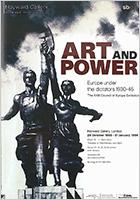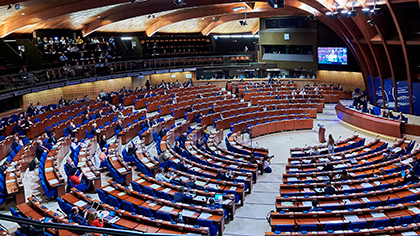Agrégateur de contenus

The Art Exhibitions of the Council of Europe
1954-2007
David Mardell

The basic aim of the Convention was to exchange ideas and pool experience to assist member governments in drawing up sound policy guidelines in the cultural domain. These included regular Conferences of Ministers of Education and Culture as well as the organization and implementation of joint projects intended to engage public interest and support cultural initiatives all across Europe. The practically-inclined as well as far-sighted minds of those early days conceived a series of major exhibitions of European art to this end, the very first of which, through a combination of intense commitment and joint effort, opened three days before the Convention itself! This exhibition was very appropriately devoted to Humanism, a value that has not only characterized the joint history of Europe itself but which it was felt could unite the entire world.
After that historic beginning, some thirty exhibitions were subsequently held across Europe which illustrated practically all the great artistic styles of their shared history. They began with the Bronze Age and passed through the Middle Ages right up to the 20th century, covering Byzantine, Romanesque and Gothic art, as well as the Renaissance, the Classical, Romantic and Historicist periods. These exhibitions also evoked many major events and movements that have left an indelible mark on European history and civilization, such as the Viking ‘expansion’, the Portuguese ‘discoveries’, the founding of the Swiss Confederation, and the French Revolution.
The exhibitions proved hugely popular all across Europe. Each one attracted several hundred thousand visitors, and sometimes even more. Their success encouraged us, in the early 1990’s, to liberate them from their fixed venues in the various European capitals, and make them increasingly itinerant, so that many more people could be exposed to and stimulated by them. They were also considered to be sufficiently important to be opened by the Head of State of the host countries. One remarkable event was the opening of the 25th exhibition, on “War and Peace in Europe” in Münster in 1998, attended by 20 Heads of State!
These exhibitions not only brought art and culture into temporary display but also engendered research and lasting co-operation between scholars and participating institutions all over Europe. The catalogues they produced remain the source of invaluable research even to this day and are still recommended for university courses. It should also be mentioned that, thanks to the holding of a major exhibition in the series, certain new museum departments were set up in several capitals, such as Florence, for example, as well as Lisbon and Istanbul.
To maintain the quality and scope of the series, the Secretariat of the Council of Europe decided to set up a ‘Group of Advisors’ for its exhibitions in the early 1980’s. This Group, later called the ‘Consultants’, consisted of the directors of some of the most important museums in Europe. Initially, there were just seven these: the British Museum, the Rijksmuseum, the Louvre, the Städel, the Pitti, the Prado, and the Albertina in Vienna. But after the fall of the Berlin Wall, we all agreed to extend membership eastwards and include countries that had been under the Soviet regime. This meant bringing in leading figures of culture such as the Director of the Hermitage Museum in St Petersburg, for example.
The eminent role of this Group, which ensured widespread confidence in the quality of the exhibition series, enabled us shortly afterwards to launch a voluntary contribution scheme. According to this, member States paid a sizeable annual subscription to support the exhibition series, a practice that was to endure for almost thirty years. The Group not only discussed, proposed and planned the exhibitions with the Secretariat but was also able to guarantee the loan of major works from their own collections. It also had the task of examining and deciding on any proposals for exhibitions in the series tabled by member States.
It was during this period that we decided to embrace the notion of change in the exhibitions themselves. Initiated in 1954, during the Cold War period, the original purpose of the exhibitions had always been to demonstrate the basic unity of European art and thus strengthen the notion of belonging to a wide European culture. But now, with all the recent upheavals, and notably the collapse of the Soviet Union, it was more appropriate to devise exhibitions that were capable, according to our mandate, “to explore the powerful interplay between society and art, between political and economic power and artistic creation”. Here again, the participation of the Group of Consultants was of prime importance in devising new themes in line with the principles and policies of the Council of Europe. One notable example was the 23rd exhibition, “Art and Power, Europe under the dictators 1930-45” which was opened in London, Barcelona and Berlin in 1995-6, very soon after the collapse of the Soviet Union. We also made plans for future exhibitions about Europe after World War Two showing the huge influence on its art and architecture over the centuries by other civilizations from around the world. These might still be on the cards…
From 1979 to 2007, I was fortunate enough to be involved in the planning and organization of more than a dozen exhibitions in the series. Their success naturally inspired further projects which we were often called upon to assist and implement, in turn. Sometimes, they occasioned some memorable experiences. In the early 80’s, for example, a pleasant young Japanese man came to my office requesting assistance from the Council of Europe for a big exhibition of European Art in Tokyo, which was to be financed by Yomiuri Shimbun, a major newspaper. After discussing the proposal with the Consultants, we set about composing a team of participant museums (including even the Metropolitan Museum in New York) in order to define the theme before we began. It was soon agreed to propose “Space in European Art” because of the significant differences between the depiction of space in visual art in the Far East and in Europe over the centuries. The hosts agreed and shortly afterwards I was invited to Tokyo. But to my surprise, I found myself whisked off to the Imperial Palace for a meeting with the Emperor’s brother and the ambassadors of Council of Europe member States. Sitting there in isolated splendour, I saw our host’s wife approaching me, accompanied by a very nice interpreter. HIH immediately began questioning me about windmills. But on seeing that I was not much up on the subject, her interpreter came to my side after a few moments and whispered in my ear: “You are the Ambassador of the Netherlands, aren’t you?”
In spite of my ignorance of windmills, the exhibition proved an enormous success and really put the wind in our sails! It covered the best part of European history from ancient Greece up to 1914, with works by some of the most prominent European artists - Michelangelo, Cranach, Dürer, Bruegel, Degas, to mention just a few - and from March to June 1987, every underground carriage in Tokyo carried a dozen or so posters with our Organization’s name prominently displayed. Never has the Council of Europe had such publicity!
A second example of a project inspired by the series was the “Exhibition-Dialogue on Contemporary Art” organized in Lisbon in 1985. The idea was to help Portugal catch up with contemporary creative expression, which had not been encouraged by post-war right-wing regimes. But it almost didn’t come off. One evening, I came to the hotel to find the organizing team in a rage; they had discovered that the contemporary art museum in Amsterdam was planning to send off its collections inter alia to Lisbon while carrying out restoration work on the museum – a brilliant idea that the Dutch have used more than once. But our team strongly resented the fact that an exhibition of contemporary art was being organized and shown before their own, beautifully planned, and highly pedagogical show. Several members even threatened to withdraw.
The following morning I asked to see the President of the Gulbenkian foundation. Within a few minutes, he agreed to provide a large sum to organize live performances in conjunction with ‘our’ event and when I went back to tell the team, to my relief, everyone immediately agreed to pursue the project. It saved the day as well as the exhibition which was, once again a magnificent and historic occasion, illustrating major art works and installations acquired by the seven participating museums over the preceding fifteen years.
But this ‘near disaster’ was not my last with that particular exhibition. After a long day’s work in Lisbon, I decided, together with Olle Granath, the director of the Stockholm Moderna Museet, to go for a refreshing swim in the ocean. But we both forgot that we weren’t on the Mediterranean coast with its insignificant tides. So arriving back on the beach we discovered that our belongings – either out of envy or impatience – had followed us into the water! Gathering up what we could, we rather sheepishly joined the others at a fancy restaurant in our soggy attire. But Jan Hoet, the director of the museum in Ghent, quickly came to our rescue. He ordered everyone present to undress and share their dry clothes with Olle and myself. And thus we sat down for a delicious lobster supper - some in underpants, others with no shirt on - a first “live performance” in effect, that must have made quite an impression on the other diners that evening!
The reputation we had acquired in the exhibition world – as the episode in Japan had already shown – was recognized in Europe too. In the late 80’s I was approached by the magazine “Painters of the 80’s” with a daring suggestion: to organize an exhibition of contemporary artists chosen directly by the public. The idea was to convince big daily newspapers and magazines to devote space to current-day artists and ask their readers to vote. It was a challenging prospect but why not give it try? Using the journalist contacts I still had from my time in the Council’s Press Department, and with the support of many others, of course, we managed to obtain the consent of practically half the major newspapers in Europe. Unbelievably, some, like ‘Libération’, gave us two full pages on more than one occasion, just to display the works of contemporary artists. The result was a quite impressive exhibition that travelled to fifteen or sixteen countries. The Council of Europe was still able to establish partnerships with the press at this time, and this obviously impressed the public.
The exhibitions, organized by the Council and inspired by its basic values and aims, had a far-reaching impact all across Europe. From the early 80’s on, the Secretariat and the Consultants found curators and museums in all the States who were eager to translate their projects into formal proposals, linked, for obvious reasons, to national events and iconic cultural commemorations. Far from rubberstamping proposals for exhibitions proposed by member States, the Council was instrumental in guiding their vision as well as stimulating their initiative. The means we put in place, such as the Group of Consultants, and the voluntary contributions we received from the member States, were instrumental in providing a stimulus to the exhibition series that has regrettably slowed down in recent years. It is to be hoped that the vital role played by the Council in promoting cultural unity in diversity will once again be encouraged in the future.




